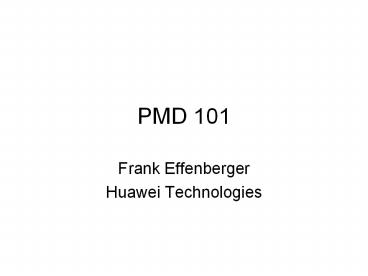PMD 101 - PowerPoint PPT Presentation
Title:
PMD 101
Description:
PMD 101 Frank Effenberger Huawei Technologies Introduction Two issues involve the interaction of PMD speed and sensitivity FEC link rate increase Dual rate OLT ... – PowerPoint PPT presentation
Number of Views:100
Avg rating:3.0/5.0
Title: PMD 101
1
PMD 101
- Frank Effenberger
- Huawei Technologies
2
Introduction
- Two issues involve the interaction of PMD speed
and sensitivity - FEC link rate increase
- Dual rate OLT receivers
- This presentation is meant to describe, in a
simple way, the basic design of PMDs - This should allow the membership to make educated
judgments when choosing alternatives that impact
speed/sensitivity
3
Photodetectors
- PIN diode
- Responsivity (A/W)
- Dark current (nA)
- Intrinsic capacitance (pF)
- Transit time (ps)
- APD
- All the above, plus
- Gain ()
- Excess Noise Factor ()
4
Noise, and the first amplifier
- There are several noise sources
- RIN noise (from the transmitter)
- Shot noise (from signal and dark current)
- Excess noise (from avalanche gain process)
- Thermal noise (from the circuit itself)
- In PIN receivers, thermal noise dominates
- In APDs, shot and excess noise play a role
- The SNR out of the first amplifier tells the
story in any (properly designed) circuit
5
Trans-Impedance Amplifier
- All modern optical PMDs use this topology
- The key idea is that the amplifiers gain reduces
the effective impedance as regards the speed of
response - Thus, a higher impedance value can be used
(better SNR) while maintaining a high response
speed (faster)
6
Circuit
Vb
R
C
Ip
B2 final LPF
Vout
A
7
Signal to Noise Ratio
- When thermal noise limited,
- SNR Ps2R/B2 (Ps/B1) (Ps/B2)
- For a fixed SNR Ps(B1B2)1/2
- When shot noise limited,
- SNR Ps/B2
- For a fixed SNR PsB2
8
The dual-rate problem
- Signals come in at different rates
- OLT must either
- Parallel process signal at both speeds (and
decide later which was right), or - Serially process signals at one speed
- This decision has to do with choice of detector
technology, and whether we are thermal noise
limited or shot noise limited
9
Parallel PMD Circuit
Vb
R
C
1Gb/s Signal 10 Gb/s signal
Ip
B21 1 GHz LPF
A
B22 8 GHz LPF
Thermal-limited Shot-limited
10
Serial PMD Circuit
Vb
Control signal
R2
R1
C
1Gb/s Signal 10 Gb/s signal
Ip
B21 1 GHz LPF
A
B22 8 GHz LPF
Thermal-limited Shot-limited
11
Comparison of Serial and Parallel
- In shot-limited case, there is no difference
- Pre-amp circuit does not impact SNR
- In thermal-limited case, the Parallel circuit 1G
SNR is degraded by factor B1/B12 8 - Constant SNR power penalty 4.5 dB
- Practical APD receivers fall midway between these
two extremes - Avalanche multiplication factor optimized around
M10
12
Optimized APD Gain
13
Serial and Parallelwith optimized APDs
- For an optimized APD
- SNR Ps4/3 / (B11/3B2)
- For a fixed SNR Ps (B1B23)1/4
- The Parallel circuit 1G SNR is degraded by
(B1/B12)1/3 2 - Constant SNR power penalty 2.25 dB
14
Overall Conclusions
- Dual rate optics present us with a choice
- Implement the serial circuit approach
- No sensitivity penalty
- Complexity of transimpedance control
- Implement the parallel circuit approach
- Simpler transimpedance amplifier
- Approximately 23 dB sensitivity penalty (APD) or
4.5dB penalty (pin)
15
Sensitivity versus Speed (FEC)
- For a normal receiver, B1B2B
- We can see that SNRf(P/B) for a receiver with an
optimized pre-amp - So, a 0.28 dB increase in speed will require a
0.28 dB increase in received power for a constant
SNR































